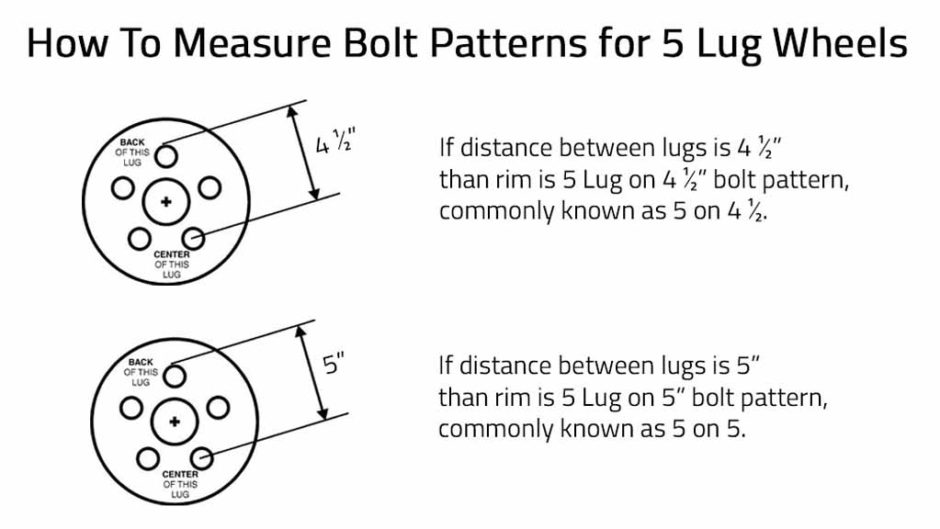Unlocking Your Car's Bolt Pattern: A Simple Guide

Ever wondered about those bolts holding your wheels in place? They're more than just fasteners; they're a key component of your vehicle's safety and performance. Knowing how to determine the arrangement of these bolts, commonly called the wheel lug pattern or bolt pattern, is surprisingly important. This guide will simplify the process of identifying your car's specific bolt pattern.
Understanding your car's bolt pattern is crucial when replacing or upgrading your wheels. An incorrect bolt pattern can lead to vibrations, wheel detachment, and potentially dangerous driving conditions. Fortunately, figuring out this vital piece of information is often straightforward, requiring only a few simple tools and a little patience.
The wheel lug pattern, often abbreviated as PCD (Pitch Circle Diameter), describes the arrangement of the lug holes on a wheel. It's expressed as two numbers: the number of lugs and the diameter of the circle on which the lugs are positioned. For example, a 5x114.3 bolt pattern means there are five lug holes on a circle with a diameter of 114.3 millimeters.
Historically, wheel lug patterns varied widely between manufacturers and even between models of the same brand. Over time, standardization has occurred, but knowing how to determine your specific pattern remains essential. Improperly fitted wheels can significantly compromise your vehicle's handling and safety.
Knowing the correct method to obtain your bolt pattern is vital to avoid potential issues. Using incorrect measurements could lead to purchasing incompatible wheels, which can result in costly mistakes and safety hazards. This guide will walk you through the correct procedures to ensure an accurate measurement.
For wheels with an even number of lugs (like 4, 6, or 8), measure the distance from the center of one lug hole straight across to the center of the lug hole directly opposite. This is the diameter. For wheels with an odd number of lugs (like 5), the process is slightly different. Measure from the back edge of one lug hole to the center of the opposite lug hole. Then, consult a bolt pattern chart (easily found online) and use this measurement to determine your PCD.
Understanding your wheel lug pattern allows you to confidently select compatible aftermarket wheels. It ensures proper fitment, eliminating safety concerns and performance issues related to improperly matched wheels. Finally, knowing how to determine your bolt pattern empowers you to make informed decisions about your vehicle's maintenance and upgrades.
Step-by-Step Guide:
1. Securely park your vehicle on a level surface.
2. Locate your vehicle’s owner's manual, as it may list the bolt pattern.
3. If not found in the manual, locate a ruler or measuring tape.
4. Follow the measuring procedure outlined above based on whether you have an even or odd number of lugs.
5. Double-check your measurement to ensure accuracy.Advantages and Disadvantages of Knowing Your Wheel Lug Pattern
| Advantages | Disadvantages |
|---|---|
| Ensures correct wheel fitment | Requires a small amount of time and effort |
| Prevents safety hazards related to improper wheel installation | |
| Enables informed decisions about wheel upgrades |
Frequently Asked Questions:
1. What tools do I need? A ruler or measuring tape is generally sufficient.
2. Where can I find my car's bolt pattern? The owner's manual is a good starting point, or you can measure it yourself.
3. What happens if I install wheels with the wrong bolt pattern? This can lead to vibrations, wheel detachment, and dangerous driving situations.
4. Is measuring the bolt pattern difficult? Not at all, it's a straightforward process with a few simple steps.
5. Do all cars have the same bolt pattern? No, bolt patterns vary between manufacturers and models.
6. Why is the bolt pattern important? It ensures the wheels are securely attached to the vehicle.
7. Are there online resources to help identify bolt patterns? Yes, many websites offer bolt pattern guides and charts.
8. Can I determine the bolt pattern from the tire size? No, tire size and bolt pattern are independent measurements.
Tips and Tricks: Double-check your measurements. Use a bolt pattern guide to verify your findings. If unsure, consult a tire professional.
In conclusion, understanding how to check your wheel's bolt pattern is a fundamental aspect of car ownership. While seemingly a minor detail, the bolt pattern plays a significant role in ensuring vehicle safety and performance. By taking a few minutes to identify your vehicle's bolt pattern, you empower yourself to make informed decisions about wheel replacements and upgrades, avoiding potential safety hazards and ensuring a smooth, comfortable, and safe driving experience. Knowing how to identify your bolt pattern is a small investment of time that can yield substantial dividends in safety and peace of mind. Don't underestimate the importance of this seemingly simple measurement – it could be the key to preventing a serious accident and enjoying trouble-free driving for years to come. Take the time to learn and understand your vehicle's bolt pattern today. Your safety, and the safety of others, depends on it.
Unlock the warmth hubbard squash paint color inspiration
Deku and ochaco matching profile pictures a closer look
Sherwin williams virtual taupe exterior the ultimate guide













